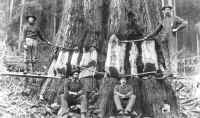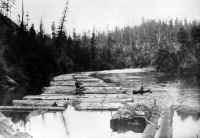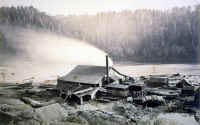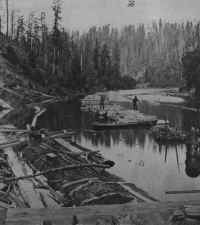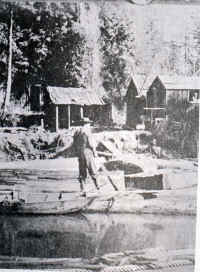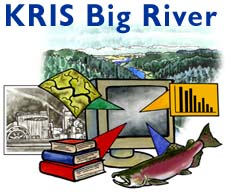Bibliography Background About KRIS
Big River History: Logging and Mills, 1852 - 1899
Photos provided courtesy of the Mendocino Historical Society and the Held Poage Memorial Home and Research Library. From the collection of Robert Lee. The Bancroft Library at U.C Berkeley also allowed use of a few select photos of the area from their Watkins collection. Further use of photos must be approved by the Mendocino Historical Society or the Bancroft Library. Click on the images to view at full size.
The following excerpts are from Mendocino City, A daily Journal 1852-1938 by W. Francis Jackson. Mendocino Historical Research, Inc. Copyright pending.
July 19, 1852 Brig Ontario arrived. (It carried men and equipment to build the first sawmill with was located on the Point. Its lumber sawing capacity was rated at 50,000 feet per day. On the ship were Lansing, Kelly, Carlson, Williams and Crowley)
October 10, 1854 California Lumber Manufacturing Company ordered to suspend all operations. (Writ of Attachment was handed to E. Williams and J. B. Ford by Sheriff Gilquist of Sonoma County. Writ by Godeffroy, et al, Williams, Ford, Thompson and Gibson)
May 26, 1855 Jerome B. Ford worked at the Page mill, the Company's new, and second sawmill. (The plant was located at the eastern end of the flat, near the place where logs were removed from the river. New mill's daily cut, 60,000 feet)
June 24, 1857 Fred Brown received an advanced payment from the Company which enabled him to begin logging. (This was a common practice between the company and contractor. Brown not only logged, but also harvested spars used as ship masts)
June 30, 1857 $4,135.80 was credited to logging contractor Daniel Milliken for having placed in the river over one million feet of logs during the month. (He, and others, received $4 per thousand feet for redwood and $8 for pine logs)
July 31, 1857 W. H. Kelly and Fred Brown joined forces in delivering 371,982 feet of redwood logs to the Company. (They received $1859.91 for placing the logs in the river in preparation for driving. They logged for 3 months)
August 11, 1857 George Huber and Edward Lane paid their poll tax, $3.00 each. (This amount was withheld from their wages by the Company. Their compensation for working was $1.73 per day, a monthly salary of $45.00)
November 20, 1858 Piers nearly completed. (Tibias Michaels and James P. Kennedy each received by contract $350.00 for having filled the piers with rock. These were timbered framed barriers placed in the river for stopping logs on the drive. Located 3 1/2 miles upriver)
October 28, 1861 J. C. Forner pre-empted two grassy openings which later became the Company's Upper Ranch. (Located on the Main river, up stream from Russell Brook and downstream of Martin Creek. Milliken, Clark and Johnston logged from this area)
October 17, 1863 Second mill was totally destroyed by fire. (The need for necessary timbers in rebuilding, which commenced immediately following the fire, induced the Company to reserve nearby large trees, the reason Reserve Gulch was so named.
November 27, 1865 Storm Cloud, a schooner, was discovered bottom up on the beach as the day dawned. (She had been driven on shore by heavy seas. The ship was a total loss. Jerome B. Ford and others, including the Company, were its owners)
November 11, 1870 Dearth of water at the mill. (During this period, one lighter each day was taken to Water Spout Gulch two miles upriver, filled with water, then brought down the river to enable the mill to run a few hours each day)
December 11, 1872 Mendocino Mill Company, with Jerome B. Ford listed as its agent, paid $2,312 property tax for its 20,996 acres of timberland. (All of it being in township 17 North, and Ranges 14, 15, 16 and 17 West)
September 16, 1874 Daniel Milliken closed his logging camp at the Piers. (He then opened a hand logging camp (no animals) at the Two Log Crossing Creek, now Two Log. Indian trails had crossed that tributary at two different places, hence the original name)
September 30, 1877 Henry Meiggs dies. (Founder of the Company, later escaped to South America when the business went into default. "Payments of debts should take precedence over payment of legacies" was written in his will)
September 5, 1882 At Byron Clark's logging camp near the head of Tidewater, bullpuncher Fred Bryant, with 5 yoke of oxen, moved 13 logs, totaling 20,339 feet, for a distance of over 1/3rd mile.
September 6, 1882 Bullpuncher Waldron at Robert Lockhart's logging camp with 5 yoke of oxen, pulled 18,950 feet of logs for a distance of one mile. (The camp was situated on the south side of the river, 6 miles from the mill)
November 9, 1884 Mill shut down for want of logs. (such closures occurred at any time, even as early as February. Reasons for shutdowns varied: no log drivers, jammed during drives, lack of freshets or not enough rain)
May 6, 1885 Alfred R. Johnston granted a land patent for 160 acres of timberland on Dougherty Creek. (In his 20 years on the upper Southfork, he was to establish 7 known logging camps, built or operated 7 logging dams)
May 29, 1885 Logging contractor Alfred R. Johnston acquired timberland on the Southfork, near Portuguese Frank's place. (A logging dam was built at this site, and another on a nearby Johnston Creek, the only two viewable from the same point)
November 9, 1885 Company secured a logging dam site on the Main River, midway between Valentine and Martin Creeks. (The 36-mile dam, also known as Log Dam, was constructed entirely of logs which were attached (held together) by wooden dowels)
December 4, 1885 James Draffin interred, having been killed in a log sluicing operation at the 36 mile logging dam. (Sluicing logs was a procedure in which logs were moved through a dam's gate/flume after the water had lowered behind it)
December 29, 1887 Edward Hatch closed down his logging camp, located up the river from Two Log Creek. (He had begun logging in the early 1880's, soon became a logging boss. He had two camps, and at each location the gulch became known as Hatch Gulch)
November 30, 1889 Mill shut down to institute a new sawdust disposal system (The County's Fish Commissioner had ordered the mill closure, stopping the sumping of waste products into the river, where they were moved by tidal action of the river)
Jan. 24, 1890 Mill began operating after being closed by a County Official, six months earlier. (A new sawdust disposal system was completed, a conveyor chain which moved the sawdust to a burning area away from the mill and river)
October 11, 1890 Logging contractor Alfred R. Johnston obtained timber land on the tributary upon which Horsethief, or Al's big logging dam was constructed. (This logging device was the most distant from the mill, 48 miles.)
Jan 23, 1894 Walter Anderson, manager of the Company's lower ranch, and his helper, Stimulous Loveland, began repairing storm damage caused 2 days earlier. (the cookhouse had to be cleaned, road downstream to other camps repaired and re-opened)
April 30, 1894 Charles A. Perkins, logging contractor, dispatched two wagons to the Lower Ranch for potatoes. (Many such ranches dotted the river, raising staples for the various logging camps and grain for the work animals)
September 4, 1899 Logging contractor Charles A. Perkins opened a camp at Burnt Jam at the foot of High Chute Ridge. (Located about one mile up the river form Laguna Creek. It was also to be the site for the railroad tie elevator)
October 11, 1899 First steam skidder used on the river arrived on the Point Arena, and was taken up the river to its consignee, Charles A. Perkins. (This particular skidder was put into operation at Burnt Jam, upriver from Laguna Creek)
Infrastructure - railroads, boats, bridges, etc.
Events - floods, storms, shipwrecks, etc
Logging / Mills - operations and events at mills, logging activities
Also see, Big River Was Dammed (excerpts) and Fish stories from the past
Photo: Joshua Grindle at camp in the 1870's. Photo by CE Watkins, courtesy of the Mendocino Historical Society and the Held Poage Memorial Home and Research Library (from the Collection of Robert Lee). (555 KB)
